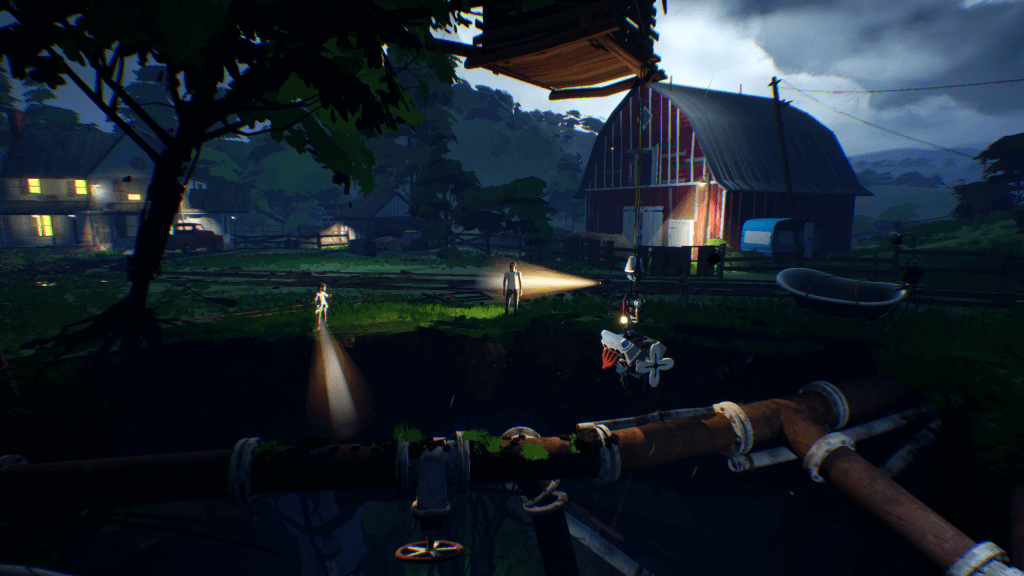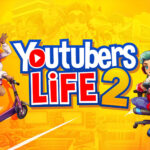Where The Heart Leads was reviewed on a PS4
Where The Heart Leads is a game about life, family, relationships and making hard decisions. You explore the life of a man named Whit as he reminisces about his life and contemplates about the choices he made. Explore his past relationships and help shape them by making his toughest decisions for him. Will you spill your brother’s secret? Will you treat your children like an authoritative figure? Or will you be their friend? Will you choose to pursue a stable career, or take risks and follow your dreams? These are just a few of the many decisions you’ll make during the game’s lengthy narrative.

What is Where The Heart Leads?
Where The Heart Leads is a story driven game that’s mostly focused on making tough life decisions. It’s a relaxing, introspective experience with some gorgeous, colorful and bright watercolor painting-like visuals.
After a night disturbed with earthquakes and tremors, Whit Anderson, the game’s protagonist, finds himself in a life or death situation, as he sinks to a bottomless sinkhole while trying to rescue the family dog. While stuck deep underground, Whit will start to recall all of the choices he made during his life. You’ll get to meet his friends, family and all of the complex characters that inhabits the game’s town of Carthage. Each chapter of the game is set in a different decade of Whit’s life.
The game uses an isometric view and gives you the ability to zoom in and out. Although I have to say that, the camera often feels too far away even when zoomed in. The dialogues and conversations are told through speech bubbles since there’s no voice acting. Thankfully, though, the developers added the ability to change the size of the speech bubbles. There’s also a log where you can review all of the past dialogues, so you’re never at any risk of missing out if you skipped a line too quickly.

Nothing’s Quite Like Family
By the end of your playthrough, you’ll get to learn more about the game’s characters than you know about your own family. After all, you witnessed almost the entirety of their lives, and even helped shape them through your own choices. The narrative tries to tackle multiple subjects at once, but it masterfully handles almost all of them. Sibling rivalry, Whit’s issues with his dad, growing up, being a bills-paying adult, chasing one’s dreams and even parenting and raising your kids; these are all some of the issues that the game tackles.
Each of them present you with a list of tough decisions to make, such as early on when you have to decide whether or not to spill a secret about your brother that could potentially get him in some serious trouble. I was often comparing my own life’s decisions to those of Whit’s during my playthrough.
Explore The Rural Town of Carthage
A large chunk of the game is set in the quaint town of Carthage, a rural town where people are more concerned about traditions and resisting change than actually trying to improve their lives. This causes Sege, Whit’s brother, to take advantage of every opportunity he can get to show off his full creativity. Carthage is a source of frustration for the tortured artist. This conundrum often pops up in the game, and it’s something that both Sege and Whit are suffering from.
When the characters of where the heart leads argue and discuss things, they raise a lot of questions and ideas that will challenge your current beliefs. The game succeeds at forcing you to reflect on your own life as well when it’s tackling a relatable subject. However, it fails to make certain parts of Whit’s life interesting enough for them to elicit a feeling of relatability towards them, out of you. For example, since I never had to be a struggling artist, I often felt that Whit’s and his brother’s subplots on the subject were a bit boring for me.
What that ultimately means is that your enjoyment of the game’s different stories and plots relies on your own real life experiences. Where The Heart Leads simply fails to provide a narrative that succeeds at making the mundane aspects of being an adult interesting enough.
A Lack Of Interactivity
What hurts the game the most is its lack of interactivity. Where The Heart Leads feels like a glorified comic book, as the only real gameplay here is the ability to walk and read the dialogues. I would have loved it if it introduced a bit of puzzle solving or at least a gameplay mechanic that can shake things up a bit occasionally. The lack of voice acting can make playing the game feel like a chore at times. Having to read the large walls of texts, no matter how engaging or compelling it is, can get tiresome.

Because of that, the game loses momentum halfway through and starts to get a bit stale as you’re frequently forced to go back and forth across town to talk to the different characters. Carthage’s map is a bit large in the second chapter and so it tends to be a bit daunting, especially since the game doesn’t guide you on where to go or what to do next. The arc about Sege and Whit’s artistic abilities also felt like a retread during the second chapter.
Their constant anguish of having to choose between being commercial artists and making risky designs was brought up way too many times. Another issue that kept popping up was that the Andersons always had bills to pay; Whit spent most of his adult life trying to get a stable job, which was a bit unrealistic considering his many talents.
Plenty of Replayability
There’s plenty of decisions and choices to make in Where The Heart Leads. Thankfully, a lot of them can have far-reaching consequences, giving the game plenty of replayability. It even features multiple endings and the lives of the characters can drastically be altered depending on your choices and decisions. The game also features more than 20 hours of playtime, giving you plenty of value even if it does get a bit tedious half way through.

Overall,
Where The Heart Leads is like a piece of art. It deserves to be appreciated and praised, even if it’s not as practical as you’d hope it to be. The narrative and the story told here is captivating and engaging, and although it’s a slow burner, I was hooked for its entirety.
The lack of any engaging gameplay mechanics however really hurts the game. Aside from holding down a button to take certain actions or choosing what comes out of Whit’s mouth next, there’s nothing interesting to do in the game.
As a narrative-driven game though, Where The Heart Leads is definitely worth the price of admission.
If you like our content and would like to support us, please consider donating to us by clicking here.
Special thanks go to Armature Studio for providing us with a review code.
For more of our gaming coverage, check out our reviews and feel free to also follow us on Instagram and Twitter. Don’t forget to also subscribe to our YouTube Channel.

You should play Where The Heart Leads if you
- Love a captivating narrative
- Enjoy an introspective experience
- Don’t mind the slow pace
- Like the painting-like visuals
- Love a rich and varied cast of characters
- Don’t mind the lack of varied gameplay mechanics
- Love a laid back and relaxing game

Where The Heart Leads Score
8/10

Where The Heart Leads
- Developed by: Armature Studio
- Published by : Armature Studio
- Platforms: PS4, PS5
- Release Date: July 13, 2021

Latest Posts:
- Session: Skate SimDespite its flaws, Session is a fun, rewarding and challenging skating simulator
Platforms: PS, PC, Xbox One, Switch - Martha is DeadInvestigate the death of your twin sister Martha in this chilling and disturbing first person psychological thriller
Platforms: PS4/5, PC, Xbox One/Series - Submerged: Hidden Depths PreviewPreviously a Stadia Exclusive, Submerged: Hidden Depths is finally coming to PC, PlayStation and Xbox Consoles.
Platforms: PS4, PC, Xbox One, Switch - YouTuber’s Life 2Fulfill Your Lifelong Dream Of Becoming An Internet Sensation In This Charming Recreation Of What It Means To Be A Professional YouTuber
Platforms: PS4, PC, Xbox One, Switch - BPM (Bullets Per Minutes)Rip up demons in a rhythmic trance of blood and metal guitar riffs in Bullets Per Minute’s dungeons of hell.
Platforms: PS4, PC, Xbox One - Agatha Christie: Hercule Poirot – The First CasesHeavily inspired by the books, Hercule Poirot’s latest investigation is a captivating one.
Platforms: PS4, PC, Switch, Xbox One






